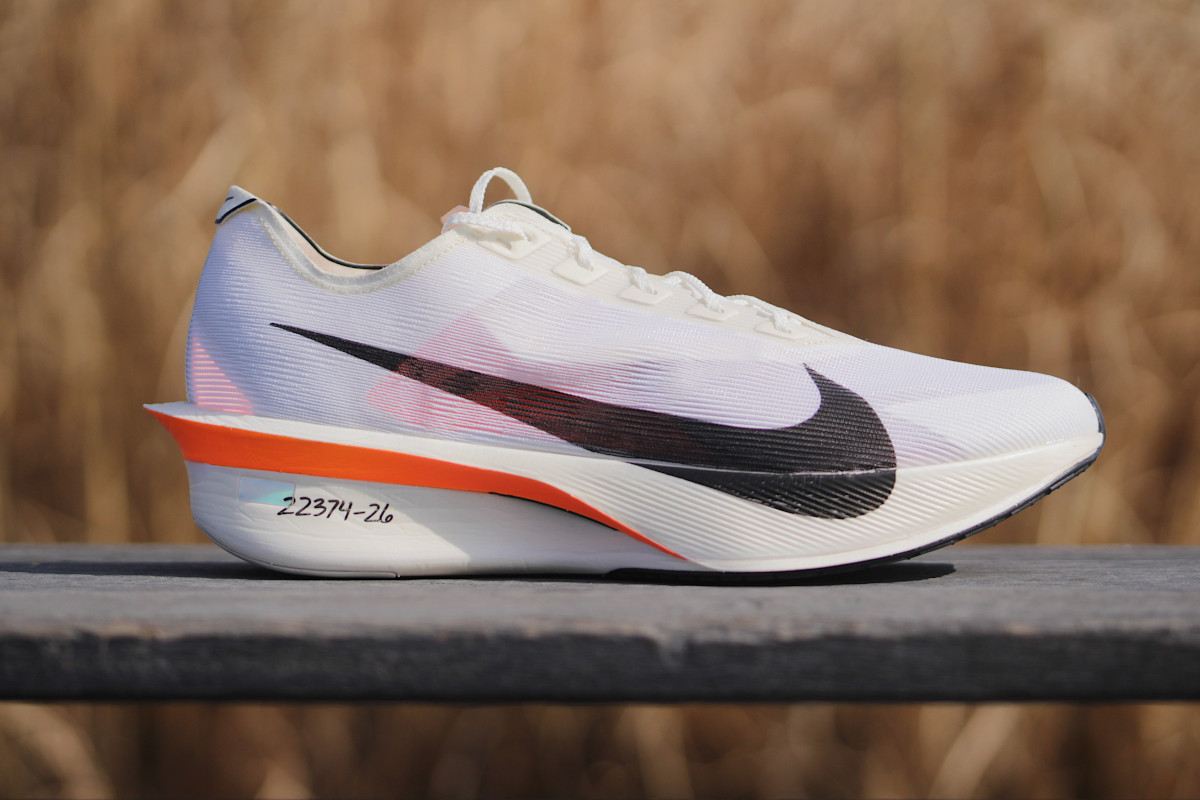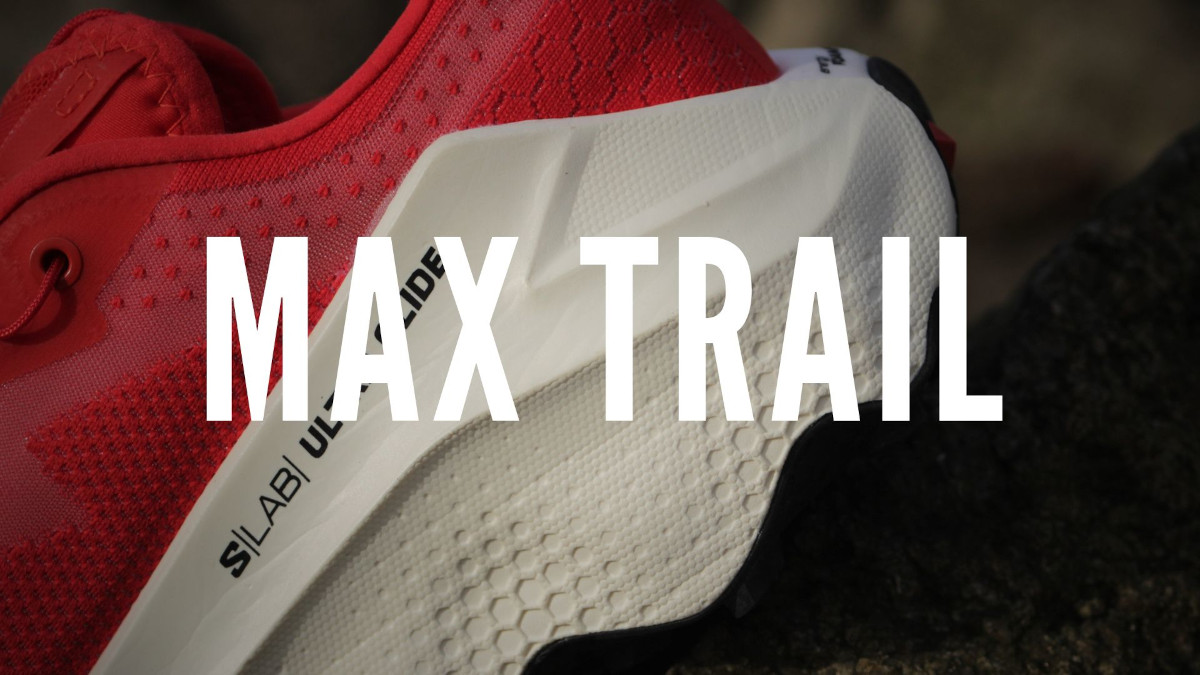Light as a feather, sleek as a bullet-that’s the latest Nike Vaporfly 4. This model isn’t a revolution, but rather a precise cut with a scalpel. A little less foam, a little more pep. Instead of a pure marathon shoe, we have a rocket that works best for shorter distances. Five kilometers? Ten kilometers? Half marathon? It will feel like a walk in the park. Marathon? Also, but Nike is increasingly emphasizing that the Alphafly model is intended for the longest races. What will we find in its lighter brother?
Basic info
Tech specs
Purpose
The Nike Vaporfly 4 is a lightweight, advanced running shoe designed for distances from 5K to half marathon. It offers a high level of cushioning, which is especially important for longer distances. It is also a shoe for fast and advanced runners. To get the most out of this shoe, you need to run about 4:00/km or faster. At a slower pace, it simply wastes its potential.
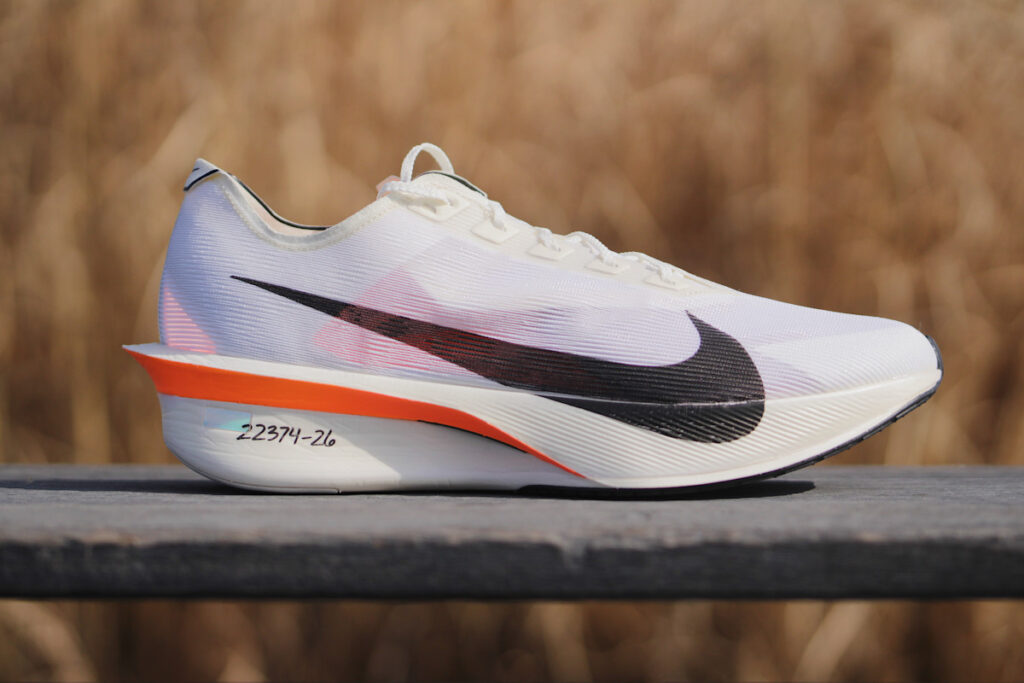
Pros
- extremely dynamic
- ideal for fast racing,
- high cushioning
- very light (among the 3% lightest running shoes)
- precise upper fit
Cons
- Narrow fit that may not suit runners with wider feet
- insufficient heel support
Nike running shoes – lineup breakdown
In the world of Nike running shoes, there is already a clear order. At the top are two beasts: Vaporfly and Alphafly-both designed to break records, but each with slightly different preferences. The Vaporfly is a lighter and more versatile shoe. It will perform better at shorter distances – from a 5K to a half marathon. Alphafly, on the other hand, is a typical long-distance runner – it likes to spread its wings at half and full marathons.
But Nike does not only offer running shoes for advanced runners. There is also the Zoom Fly, which is ideal for less advanced runners for fast training sessions and occasional races. It is a happy medium between a race shoe and a training shoe. For fans of shoes without a carbon plate, we have the Pegasus Plus and the minimalist Streakfly. There is something for every pace and distance.
Learn more about Nike shoes, not just racing shoes, in this overview.
| RACING | TRAINING AND COMPETITION | |
|---|---|---|
| maximum dynamics |  Alphafly 3 | |
| very high dynamics |  Vaporfly 4 |  Zoom Fly 6 |
| high dynamics |  Pegasus Plus | |
| mid dynamics |  Streakfly |
Alternatives to the Nike Vaporfly 4
The Vaporfly is still one of the first things that comes to mind when someone asks, “What’s the best racing shoe?” This model has been synonymous with speed and records for years. And although it has many competitors, and the top Nike racing shoe is the Alphafly, the Vaporfly is still a very fast and valuable model. It is also one of the lightest.
Want to know more? Check out the race shoe overview.
| MODEL | STACK HEIGHT (mm) | DROP (mm) | WEIGHT MEN'S (grams) | WEIGHT WOMEN'S (grams) | REGULAR PRICE (€) |
|---|---|---|---|---|---|
| adidas Adizero Adios Pro Evo 1 | 39/33 | 6 | 138 | 138 | 500 |
| adidas Adios Pro 4 | 39/33 | 6 | 200 | 175 | 250 |
| Asics Metaspeed Sky Paris | 39/34 | 5 | 205 | 205 | 250 |
| Brooks Hyperion Elite 3 | 35/27 | 8 | 230 | 230 | 250 |
| Diadora Gara Carbon 2 | 40/35 | 5 | 220 | 220 | 290 |
| Hoka Cielo X1 2.0 | 39/32 | 7 | 228 | 228 | 275 |
| Hoka Rocket X 2 | 36/31 | 5 | 236 | 236 | 250 |
| New Balance Fuelcell Supercomp Elite v4 | 40/36 | 4 | 237 | 188 | 280 |
| Nike Alphafly 3 | 40/32 | 8 | 218 | 218 | 310 |
| Nike Vaporfly 4 | 35/29 | 6 | 190 | 150 | 260 |
| On Cloudboom Echo 3 | 37/28 | 9 | 215 | 188 | 300 |
| Puma Faas-R Nitro Elite 2 | 40/32 | 8 | 250 | 250 | 270 |
| Salomon S/Lab Phantasm | 37,5/28,5 | 9 | 219 | 219 | 250 |
| Saucony Endorphin Pro 3 | 39/31 | 8 | 204 | 176 | 250 |
Cushioning – light, slim and fast
The latest Vaporfly 4 has a noticeably slimmer midsole. Made entirely of ZoomX foam (based on PEBA material), it still provides the outstanding energy return that is the hallmark of this line. The stack is now 35mm under the heel and 29mm under the forefoot – less than in previous versions, which translates into less weight and better ground feel, but may limit comfort over longer distances, such as a marathon.
Less foam also results in a slightly slimmer overall shoe shape, which also has a design that indicates it is a race shoe for slightly shorter distances. Less foam also means less cushioning, although it is still high for a race shoe. This level of cushioning is sufficient for races from 5K to half marathon, but only the most advanced runners will use it for a marathon.

The Carbon Flyplate is also placed in the foam and is a key structural element of the Vaporfly. Its function is to increase the stiffness of the midsole and give the shoe elasticity in the heel strike phase. It works like a lever, flexing slightly during landing and releasing energy at the moment of rebound, allowing a smoother and more dynamic transition through the phases of the running stride. It is responsible for the springy takeoff and the fact that you want to run faster from the first step in the Vaporfly. The speed that results from the responsive foam and carbon fiber is impossible to ignore.
The slightly lower foam content also improves the overall stability of the shoe. The Vaporfly, like other models in this series, is not the most stable in the rear, but there has been some progress compared to the previous version. It is noticeably lower and slightly harder under the heel, which automatically reduces the “floating” sensation characteristic of previous generations. This gives the foot a more secure foothold and the whole thing feels more balanced and stable. This is not critical for fast training and racing, but even the fastest athletes need a little security under the heel.

Outsole – racing and efficient
The Vaporfly 4 uses a classic solution found in fast road shoes. Rubber has been strategically placed and concentrated mainly in the front part of the midsole, where the foot works most intensively during fast running. Compared to the previous version, the rubber layer is more extensive and covers the surface more tightly, resulting in better traction and durability.
The outsole is quite flat – only 1.0 mm deep – but this is enough to maintain good traction, especially when running from the midfoot. This construction not only works well on dry surfaces, but also performs surprisingly well in wet conditions. This is more than enough for asphalt racing.
In the back of the midsole, there are just two small rubber inserts under the heel. This is a solution that has been used in other racing shoes – on the one hand, these inserts provide minimal protection when landing, and on the other hand, they reduce the weight of the shoe. The large empty space along the midsole works in a similar way – a distinctive “window” in the foam through which the carbon fiber plate can be seen.

Upper – technology and fit in one
The upper of the Vaporfly 4 is made of technical mesh with a striped texture. Although not as thin and airy as the Vaporfly 3, it still provides excellent breathability and ventilation. Compared to its predecessor, the material is slightly more textured, which improves the fit, support and stability of the foot.
In terms of interior space, this is not a model for people with wide feet. These people may feel a bit cramped in the shoe. There is not much room, especially in the metatarsal area, which is quite tight and gives the impression of “braiding” the foot. This is typical of racing shoes. This snug fit translates into confidence at higher speeds.
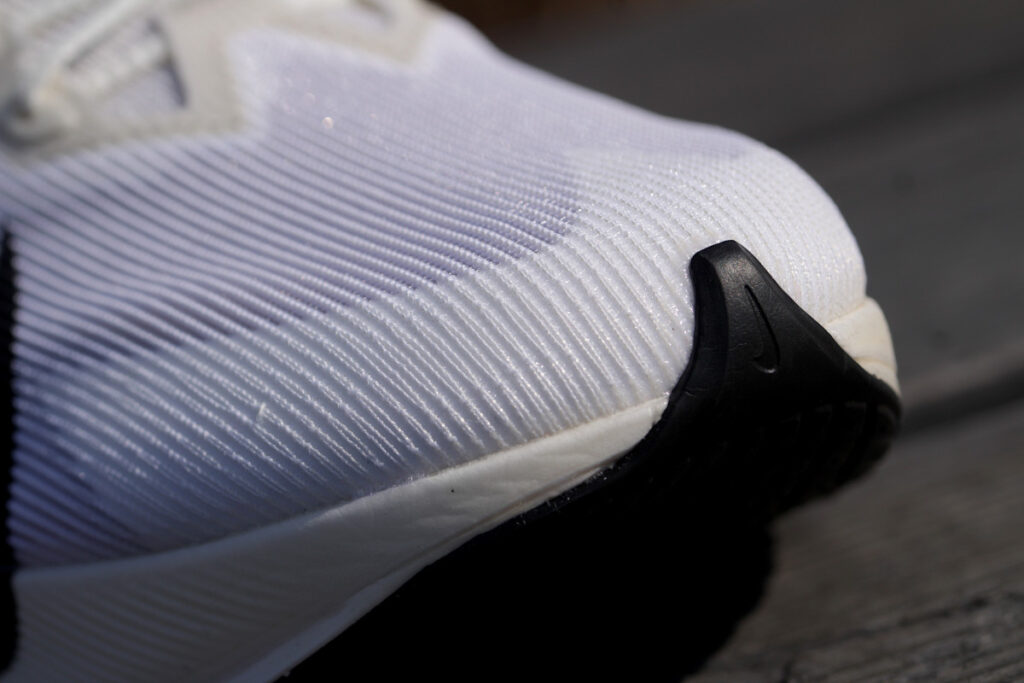
The heel counter is also lightweight. It has been slimmed down with a large amount of material and only moderately stiffened. It holds the heel thanks to special “cushions” that stabilize the foot inside the heel counter. Although the support is not comparable to that of a sturdy everyday running shoe, it makes these shoes suitable for racing. Of course, you should try the shoes on before you buy them to see how they fit, as the fit is crucial to comfort.
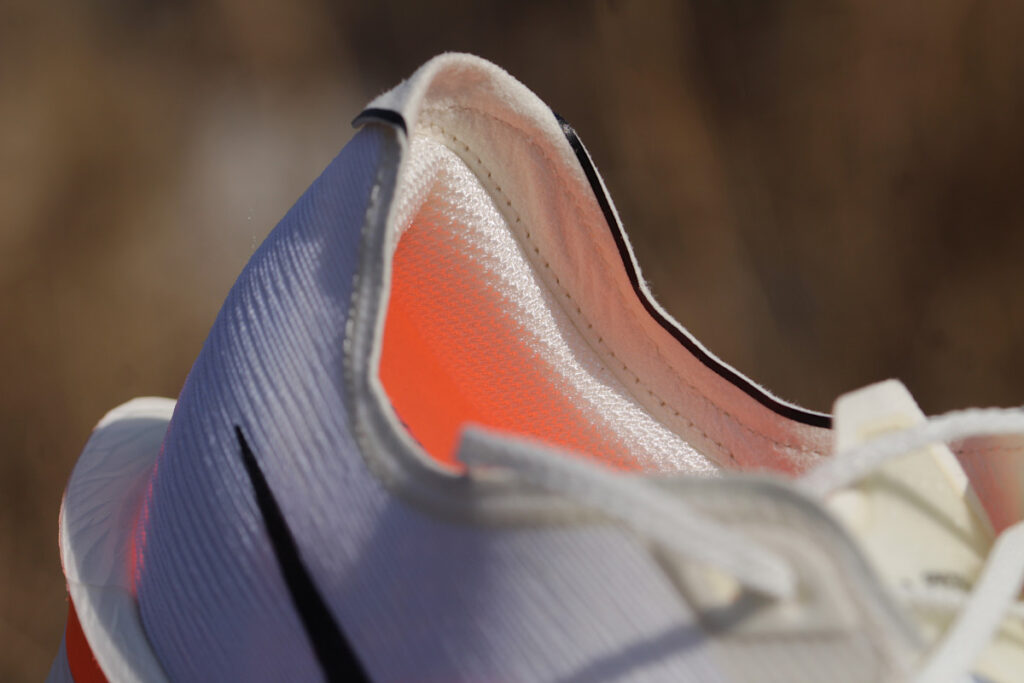
Weighing – even lighter
According to the producer, the Vaporfly 4 weighs 190 grams for men and 152 grams for women. In my case, with a size 12 US, the weight is 211 grams, which means that the model is 10 grams lighter than the previous version. On the one hand, this is such a subtle change that it is hard to notice while running, but on the other hand, even though the previous model was already ultra-light, the new version gains a few grams.
If we compare the Vaporfly 4 to the entire range of running shoes, it is in the top 3% of the lightest models. However, if we focus only on racing and training/racing shoes – designed for fast running – the Vaporfly 4 is in the top 8% of the lightest shoes. This is still an impressive result, as you would expect from a shoe in the Vaporfly line.
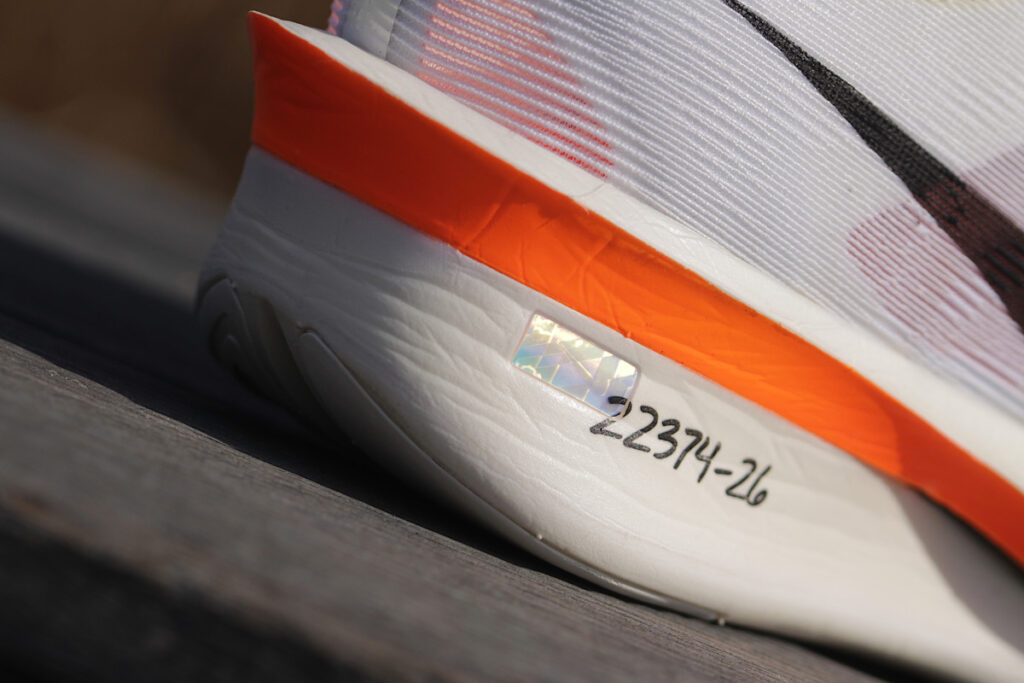
Summary
The line between the Alphafly and the Vaporfly is becoming increasingly blurred. The current Nike Vaporfly 4 is a shoe clearly designed for race distances from 5K to half marathon. Compared to its predecessor, it offers better stability and an even lighter weight at the expense of a little less cushioning. It is a great choice for fast runners, but its high price and tight fit may not appeal to everyone. Still worth it!
